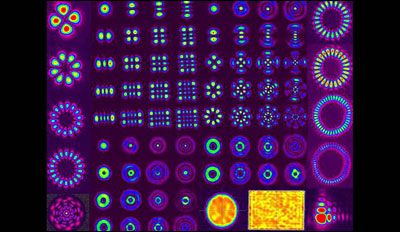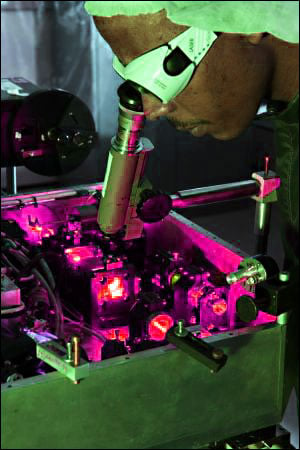
South Africans Develop ‘Digital Laser’
South Africa's Council for Scientific and Industrial Research (CSIR) held a press conference this week to announce it has developed the first digital laser, a milestone its creators say represents a paradigm shift for laser resonators.
 In their paper, described in the Aug. 2 edition of Nature Communications, the CSIR team showed that beams can be digitally controlled from within a laser. They say they overcame the limitations of using specialized optical elements to customize the output beam of a laser "comprising an electrically addressed reflective phase-only spatial light modulator as an intracavity digitally addressed holographic mirror." The phase and amplitude of the holographic mirror can be controlled by writing a computer-generated hologram in the form of a gray-scale image to the device, they said, for on-demand laser modes.
In their paper, described in the Aug. 2 edition of Nature Communications, the CSIR team showed that beams can be digitally controlled from within a laser. They say they overcame the limitations of using specialized optical elements to customize the output beam of a laser "comprising an electrically addressed reflective phase-only spatial light modulator as an intracavity digitally addressed holographic mirror." The phase and amplitude of the holographic mirror can be controlled by writing a computer-generated hologram in the form of a gray-scale image to the device, they said, for on-demand laser modes.
Laser light can be shaped after exiting a laser using a spatial light modulator — a liquid crystal display (LCD) that can be digitally addressed with gray-scale images representing the desired change to the light. The CSIR team is the first to demonstrate that this can all be done inside the laser.
 "Our digital laser uses the LCD as one of its mirrors that is fitted at one end of the laser cavity. Just as with LCD televisions, the LCD inside the laser can be sent pictures to display. When the pictures change on the LCD inside, the properties of the laser beams that exit the device change accordingly," said professor Andrew Forbes, leader of CSIR's mathematical optics research group, where the work was done. Forbes, who in March became the first South African inducted as an SPIE Fellow, led the team, supported by postdoctoral fellow Dr. Igor Litvin and doctoral students Sandile Ngcobo and Liesl Burger.
"Our digital laser uses the LCD as one of its mirrors that is fitted at one end of the laser cavity. Just as with LCD televisions, the LCD inside the laser can be sent pictures to display. When the pictures change on the LCD inside, the properties of the laser beams that exit the device change accordingly," said professor Andrew Forbes, leader of CSIR's mathematical optics research group, where the work was done. Forbes, who in March became the first South African inducted as an SPIE Fellow, led the team, supported by postdoctoral fellow Dr. Igor Litvin and doctoral students Sandile Ngcobo and Liesl Burger.
"We showed that by sending an appropriate picture to the LCD, any desired laser beam could be created inside the laser device," Forbes said. "This is a significant advancement from the traditional approach to laser beam control, which requires costly optics and realignment of the laser device for every beam change. Since this is all done with pictures, the digital laser represents a paradigm shift for laser resonators."
"I believe the digital laser will be a disruptive technology. This is
technology which may change the status quo and which could create new
markets and value networks within the next few years or decade," said
Ngcobo, who conducted the work as part of his Ph.D. studies at the
University of KwaZulu Natal.

Myriad laser beam shapes generated from the digital laser. No new optics or alignment was necessary to create these laser beams. In a traditional laser, it would have been impossible to do this in one device; usually, a new device would have been required for each beam shape. Courtesy CSIR.
Lasers are a multibillion-dollar industry worldwide, and "the development of the digital laser opens up a whole new world of opportunities," said Minister of Science and Technology Derek Hanekom at a media event on Tuesday announcing the device. In announcing the advance, Hanekom compared the CSIR team to other notable South Africans, such as cardiac surgeon Dr. Christiaan Barnard and physicist Allan Cormack, who shared the Nobel Prize with countryman Godfrey Housfield.
"This groundbreaking development is further evidence of the great potential we have in scientific innovation — that the world's first digital laser should come from our country is testimony to the caliber of scientists that South Africa has," Hanekom said.

CSIR researcher Sandile Ngcobo in the lab. Courtesy CSIR.
At the press conference, Hanekom read a statement from Dr. Igle Gledhill, president of the South African Institute of Physics, who said, "This is what is often termed a breakthrough — and it is a real breakthrough. The digital laser opens up new visions of laser applications, and there are uses that we haven’t even thought of yet. In that way, it’s very much like just like the original invention of the laser over 50 years ago."
At the CSIR’s laboratories in Pretoria, the team programmed the LCD to play a video of a selection of images representing a variety of desired laser modes. The result was that the laser output changed in real time from one mode shape to another.
“The dynamic control of laser modes could open up many future applications, from communications to medicine. Our device represents a new way of thinking about laser technology, and we see it as a new platform on which future technologies may be built,” Forbes said.
For more information, visit: www.csir.co.za or (Nature Communications 4, no 2289, doi:10.1038/ncomms3289)
Published: September 2013